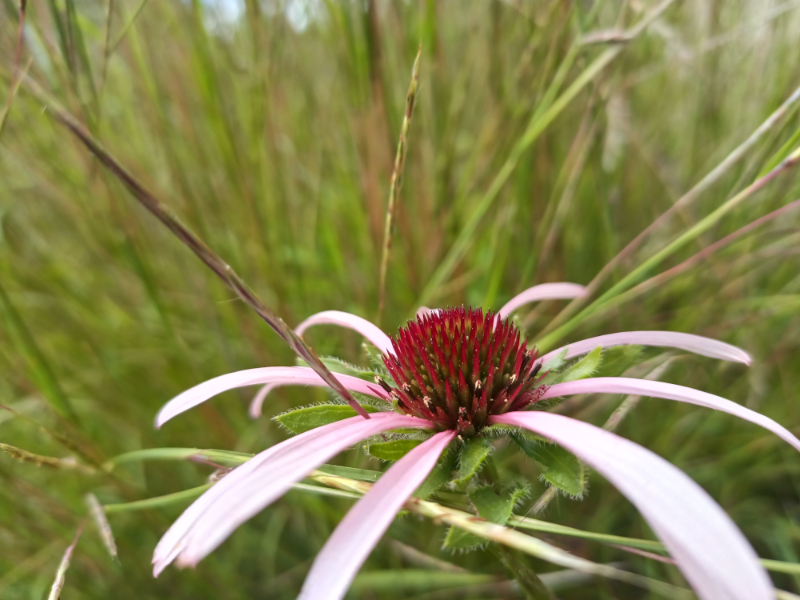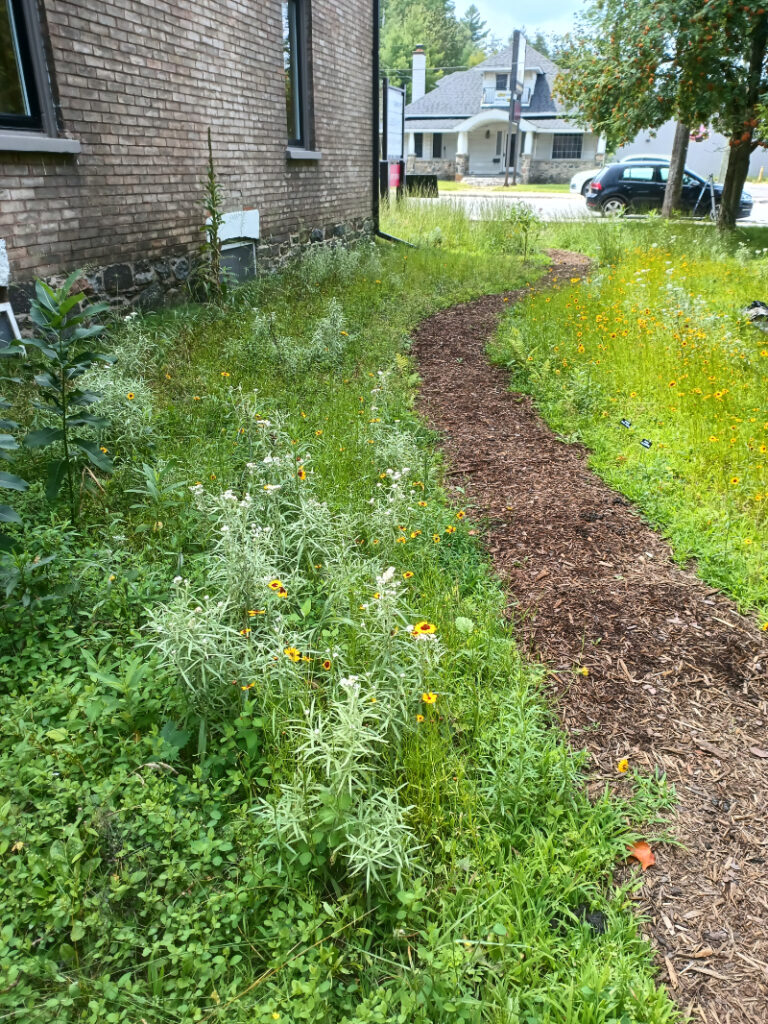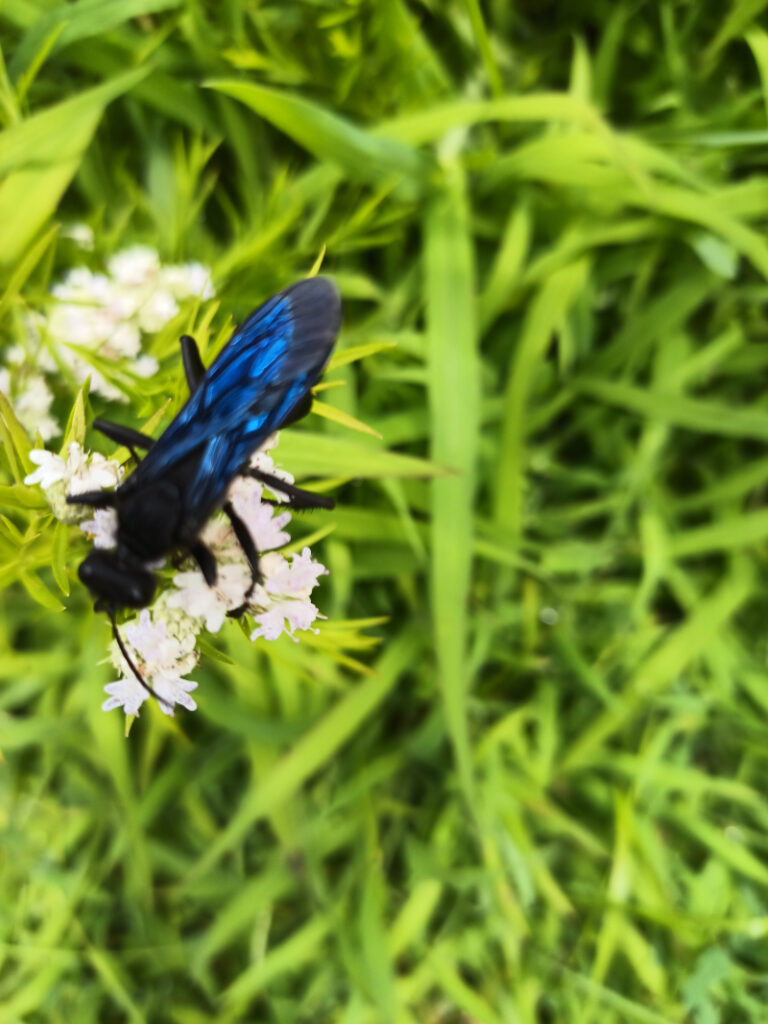
Myths about Native Plants and Natural Gardens
At Grounded, we hear a lot of myths about natural gardens and the native plants they host. Here’s my personal takedown of this fake news.
Table of contents
- Myth: All non-native plants must be ripped out
- Myth: Natural gardens are zero maintenance
- Myth: Native plant gardens must be messy
- Myth: You can have native plant gardens that look exactly like cultivated gardens
- Myth: You can garden in a traditional way
- Myth: Native plants have longer roots
- Myth: I can just let my lawn grow
Myth: All non-native plants must be ripped out

I prefer native plants because they’re better (in general) at serving the needs of ecosystems. But I’m no zealot! Indeed, I find such extremism goes against the cause.
If you have non-native plants that you love, go ahead and keep them (as long as they’re not doing any harm.) The thing is, non-native plants can serve wildlife. It’s just that – in general – they don’t serve it as well and they’re less likely to serve specialist species (which are important parts of a functioning ecosystem).
The only exception is invasive plants. I’d want to rip those out because they damage ecosystems.
If you want to add non-native plants, I can try to help but I’m no expert. I might instead try to steer you in the direction of native plants and their many, many benefits.
Myth: Natural gardens are zero maintenance
A garden is a garden – it’s not wilderness. So if you have a garden, there is some management (as I like to call it) involved.
While people who claim native plant gardens are no-maintenance are wrong (and misleadingly so), I think it is possible to say that natural gardens are much less maintenance, particularly after the first couple of years. But it depends on doing it right!
You can read more about how a natural garden establishes in this article, but the bottom line is this: we design gardens to cover the ground within the first couple of years or so. There is some light maintenance and maybe watering in the meantime, but after that they are much more hands off. Management after that involves working with nature and steering it in the direction you want it to go. This is something wise humans have been doing for millennia.
Zero maintenance? No! Stewardship in harmony with nature? You bet!
Myth: Native plant gardens must be messy

There are some native plant promotors who plant a bunch of native plants and say: live with it! I think this is wrong – and it’s damaging to the cause of natives.
We’re creating gardens here, so we need to think of their aesthetic appeal. Not only do we have neighbours to please, we also want to prove to people that natural gardens can be attractive.
When we design gardens, we think carefully about how they look. We choose plants that bloom at different times of the year. We choose a variety of bloom colours. We choose a variety of plants.
We also use cues to care, which show that this isn’t a garden gone wild, it’s made with intention.
But we also say this: Go Beyond Pretty. As you’ll see in the next question, a natural garden won’t look like a traditional garden.
Myth: You can have native plant gardens that look exactly like cultivated gardens

Plants have been cultivated for hundreds of years to please us. We have to some extent seen our gardens as canvases – we paint them pretty with plants.
For this reason, cultivated plants have bigger and brighter flowers and are bred to look good. They’re made to please us.
The downside is that when you breed something for one characteristic, you run the risk of losing other characteristics. And those lost characteristics could be important for wildlife.
The most common example is plants that have been bred with double flowers. Often pollinators can’t get inside them. But there are more subtle changes that can take place that mean the plant becomes less valuable.
We encourage people to Go Beyond Pretty and change your framework as to what is aesthetically pleasing. Yes, natural gardens can look nice, but they’re beautiful in many other ways too: buzzing of life is beautiful; knowing that they are playing a role in an ecosystem is beautiful; helping the future of the planet is beautiful.
Once I got into native plants, my taste changed. I see a traditional garden now, with its massive flowers and vivid colours, and, well, I can’t help but think of Donald Trump’s taste at Mar-A-Lago.
Myth: You can garden in a traditional way
This one isn’t talked about. But I think it’s important.
There are a lot of people promoting the use of native plants at the moment, but they do it from a traditional horticulture perspective. I think this does native plants and the homeowners who have them a disservice.
Cultivated plants are bred to look good in gardens when they stand alone or in clumps. Native plants? Not so much. If, for example, you create a garden of plants separated by a sea of mulch – indeed, if you see your garden as a set of individual plants rather than a community of plants – you might be disappointed.
Traditional horticulture often says you must have a “good soil” – and if you don’t, you must amend it. But the fact is, many native plants thrive on poor soils, so if you give them too much food, they’ll suffer. After all, not all soils in nature are Grade A – plants have evolved to grow on Grade D substrates.
Use native plants the way nature intended. Plant well-suited native plants densely, in layers, and think about how the plants interact. This is how you make a successful native plant garden rather than a compromise that might make you think you’re doing good, but doesn’t make you feel good inside.
Myth: Native plants have longer roots
I hear this one a lot. People say native plants are good because they have deeper roots than cultivated plants.
This isn’t true: native plants have a variety of root depths and structures. So do cultivated plants!
I think the myth arose because people compare native plants with lawns. Turf grass (which is European in origin) has very shallow roots – you can get under them with a shovel. So any plant has a deeper root than that.
Replace your lawn with deeper-rooted plants. Use native plants and you get deep roots and many ecological benefits.
Myth: I can just let my lawn grow
Confession time: I tried this at Lucas House in 2022. Big mistake. The grass used in lawns isn’t native – most of it originates in Europe. Plus, there are so many non-native plants in North America, what you get a weedy non-natives. Then, if you let the grasses produce seeds, you are replenishing the seedbank for the future. The result: more weeds!
Instead, replace the lawn with truly native plants. Plant them densely so that the weeds from the old lawn can’t compete.
